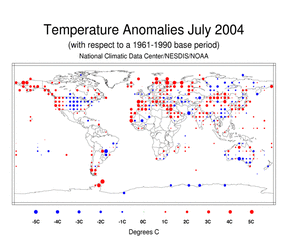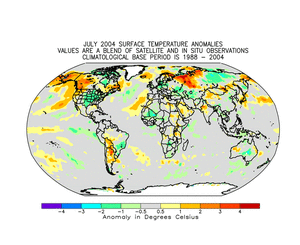Global Highlights:
|
Contents of this Section: |
| The data presented in this report are preliminary. Ranks and anomalies may change as more complete data are received and processed. The most current data may be accessed via the Global Surface Temperature Anomalies page. |
IntroductionThe two maps below utilize different base periods and may reflect different anomaly values of land surface temperatures. The dot map on the left uses anomalies that were calculated from the Global Historical Climatology Network (GHCN) data set of land surface stations using a 1961-1990 base period. The map on the right is a blended product which uses satellite and surface anomaly values of measured land and ocean temperatures as well as SSTs with the base period of 1988-2004. Both maps reflect conditions during July 2004, indicating above average temperatures in Alaska, the majority of Canada, the eastern half of Russia and Saudi Arabia, with cooler than average temperatures in the Great Plains of the US, parts of southern Australia, Mali and southern Brazil.The mean position of upper level ridges of high pressure and troughs of low pressure (depicted by positive and negative 500 millibar height anomalies on the July 2004 map) are generally reflected by areas of positive and negative temperature anomalies at the surface, respectively. For other Global products see the Climate Monitoring Global Products page. |
 |
 |
Temperature Rankings and GraphicsCurrent Month / Year-to-date
|
 |
 |
|
 |
 |
The most current data may be accessed via the Global Surface Temperature Anomalies page.
 |
 |
The satellite images below were acquired from SSM/I satellite data using a base period of 1988-2004. The map on the left reflects surface liquid wetness conditions, while the map on the right reflects snow cover conditions for the month. Snow covered areas that are normally snow-free during this month will appear drier than average on the wetness image since a wetness value cannot be determined for regions that are snow covered. Data in these areas that are normally snow covered are displayed as missing. This is due to the snow crystalline structure which produces a considerable amount of scatter and makes it difficult for the SSM/I to accurately detect the surface conditions. The SSM/I products are experimental and are under continuing review and development. Additional data and information can be found on the SSM/I Browser. |
 |
 |
ENSO SST Analysis |
|
- Images of sea surface temperature conditions are available for
all months to date during 2004
at the weekly SST page
References:Peterson, T.C. and R.S. Vose, 1997: An Overview of the Global Historical Climatology Network Database. Bull. Amer. Meteorol. Soc., 78, 2837-2849.
 NOAA's National Centers for Environmental Information
NOAA's National Centers for Environmental Information